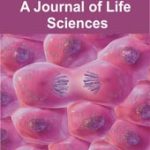
Chandra Shekhar Anugula1,

Karuna Rupula,
- Research Scholar Department of Biochemistry University College of Science Osmania University, Hyderabad Telangana India
- Professor Department of Biochemistry University College of Science Osmania University, Hyderabad Telangana India
Abstract
This study was aimed to produce recombinant human Tim23 protein by molecular cloning, expression, and purification. Amplification of human TIM23 was carried out by PCR and cloned into DH5α cells. The pET28a-human TIM23 was transformed into BL21DE3 and expressed the gene by IPTG induction. Recombinant pure human Tim23 antigen was prepared, injected into rabbit and polyclonal antibodies were raised, which was confirmed by western blotting. The transformed DH5α colonies screened for recombinant TIM23 on agarose gel electrophoresis depicted specific band corresponding to ~5.4kb pET28a vector and a band at ~0.63kb confirmed the clone. Over expression of recombinant human Tim23 was confirmed by SDS-PAGE in BL21DE3 bacterial cells followed by purification by affinity chromatography. Furthermore, polyclonal antibodies were raised and validated by immunoblotting. This study concludes a fundamental and comprehensive study on the molecular cloning, expression, purification and raising antibodies against recombinant human Tim23. Characterization of Tim23 protein will further enhance the existing knowledge on biogenesis of mitochondria. Polyclonal antibody of Tim23 could be a useful tool for validating regulatory mechanism in mitochondria.
Keywords: Mitochondria; Recombinant protein; Tim23; cloning; Polyclonal antibodies
[This article belongs to Research & Reviews : A Journal of Life Sciences(rrjols)]
Browse Figures
References
- Zwizinski C, Schleyer M, Neupert W (1983) Transfer of proteins into mitochondria. Precursor to the ADP/ATP carrier binds to receptor sites on isolated mitochondria. Journal of Biological Chemistry258(7):4071-4074.
- Vestweber D, Brunner J, Baker A, Schatz G (1989) A 42K outer-membrane protein is a component of the yeast mitochondrial protein import site. Nature341(6239):205-209.
- Chacinska A, Lind M, Frazier AE, Dudek, J, Meisinger C, Geissler A, Rehling P (2005) Mitochondrial presequence translocase: switching between TOM tethering and motor recruitment involves Tim21 and Tim17. Cell120(6):817-829.
- Wiedemann, N, Kozjak V, Chacinska A, Schönfisch B, Rospert S, Ryan MT, Meisinger C (2003) Machinery for protein sorting and assembly in the mitochondrial outer membrane. Nature424(6948):565-571.
- Chacinska A, Koehler CM, Milenkovic D, Lithgow T, Pfanner N (2009) Importing mitochondrial proteins: machineries and mechanisms. Cell 138(4):628-644.
- Popov‐Čeleketić D, Mapa K, Neupert W, Mokranjac D (2008) Active remodelling of the TIM23 complex during translocation of preproteins into mitochondria. The EMBO journal27(10):1469-1480.
- Popov LD, (2020) Mitochondrial biogenesis: An update. Journal of cellular and molecular medicine24(9):4892-4899.
- Schafer, JA, Bozkurt S, Michaelis JB, Klann K, Münch C (2022) Global mitochondrial protein import proteomics reveal distinct regulation by translation and translocation machinery. Molecular cell82(2):435-446.
- Xu Y, Xue, D, Bankhead A, Neamati, N (2020) Why all the fuss about oxidative phosphorylation (OXPHOS)?. Journal of medicinal chemistry63(23):14276-14307.
- Sanz, A, Stefanatos, RK. (2008) The mitochondrial free radical theory of aging: a critical view. Current aging science1(1):10-21.
- Webb M, Sideris DP (2020) Intimate relations—mitochondria and ageing. International Journal of Molecular Sciences21(20):7580.
- Sickmann A, Reinders J, Wagner Y, Joppich C, Zahedi R, Meyer HE, Meisinger C (2003) The proteome of Saccharomyces cerevisiae mitochondria. Proceedings of the National Academy of Sciences100(23):13207-13212.
- Gonczarowska-Jorge H, Zahedi, RP, Sickmann A (2017) The proteome of baker’s yeast mitochondria. Mitochondrion 33:15-21.
- Palmfeldt J, and Bross P (2017) Proteomics of human mitochondria. Mitochondrion33:2-14.
- Revathi Paramasivam O, Gopisetty G, Subramani J, Thangarajan R (2021) Expression and affinity purification of recombinant mammalian mitochondrial ribosomal small subunit (MRPS) proteins and protein–protein interaction analysis indicate putative role in tumourigenic cellular processes. The journal of biochemistry169(6):675-692.
- Sahdev S, Khattar SK, Saini KS (2008) Production of active eukaryotic proteins through bacterial expression systems: a review of the existing biotechnology strategies. Molecular and cellular biochemistry 307:249-264.
- Sezonov G, Joseleau-Petit D, d’Ari, R (2007) Escherichia coli physiology in Luria-Bertani broth. Journal of bacteriology 189(23):8746-8749.
- Smekenov I, Alybayev, S., Ayupov T, Rakhmatullaeva G, Bissenbaev A (2020) A polyclonal antibody against a recombinantly expressed Triticum aestivum RHT-D1A protein. Journal of Genetic Engineering and Biotechnology18:1-14.
- Leenaars, M, Hendriksen CF (2005) Critical steps in the production of polyclonal and monoclonal antibodies: evaluation and recommendations. ILAR journal46(3):269-279.
| Volume | 14 |
| Issue | 01 |
| Received | February 20, 2023 |
| Accepted | March 20, 2023 |
| Published | March 30, 2024 |


